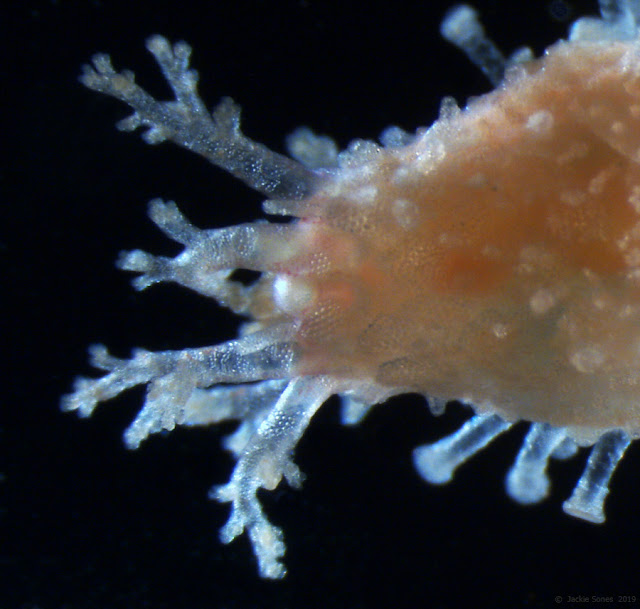Okay, remember the mystery photo from last night? Here's a reminder, with a slightly different view:
I'll zoom out a bit so you can see a little more. And yes, for those of you who were wondering, the sand grains on the tentacles are a clue:
Any guesses yet? When we first found this animal, we didn't know what it was. We had to step through various options and rule out different groups.
Did you notice that the skin adjacent to the tentacles looks shiny? Here's an extreme close-up so that you can see what I'm referring to:
Those shiny pieces are ossicles — tiny calcified plates. To help identify this organism, we looked at a few of the ossicles under high magnification (400x):
Do you have a guess yet? Think about a soft-bodied animal with a cluster of branched tentacles at one end and microscopic ossicles embedded in the body wall.
It'll probably help if I tell you that although this animal doesn't have them, most of this animal's relatives have tube feet.
Here's another look at those digitate (finger-like) tentacles:
Yes! It's a sea cucumber! We hadn't seen this species before. It's a Sand Sea Cucumber (Paracaudina chilensis). Amazingly, it's distribution includes the entire Pacific Rim (coastal South America, Central America, North America, China, Japan, Australia, and New Zealand).
As you might guess from the common name, and the pictures, this sea cucumber burrows in the sand. It ingests large volumes of sand to capture organic material from the sand grains for food (hence the "sticky fingers").
This is what the entire sea cucumber looks like (photo below — note there was debris sticking to the cucumber, but that's likely a result of being in the drift line). We found it washed up on the beach, and puzzled over it for a while. With my hand lens I could see the tentacles — that helped because the tentacles didn't look right for a peanut worm or a sea anemone.
Note the very long posterior end. This sea cucumber lives upside down in the sand (up to 50 cm deep) — tentacles down, and posterior end up near the surface.
The shape of the ossicles helped clinch the identification as Paracaudina chilensis. Many of them are beautiful three-dimensional "crossed cups." Compare the ossicle images above with this published figure from a specimen in Australia:
Modified from O'Loughlin, P.M., S. Barmos, and D. VandenSpiegel. 2011. The
paracaudinid sea cucumbers of Australia and New Zealand (Echinodermata:
Holothuroidea: Molpadida: Caudinidae). Memoirs of Museum Victoria 68: 37-65.
P.S. Are you wondering about the extra credit (i.e., the source of the brilliant red coloration in the tentacles)? Paracaudina chilensis has hemoglobin-filled blood cells (in the body cavity and in the tentacles)! The hemoglobin is likely an adaptation to living buried down in a low-oxygen environment.


















































